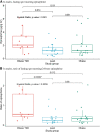Disrupted Circadian Rhythm of Epinephrine in Males With Youth-Onset Type 2 Diabetes
- PMID: 36632209
- PMCID: PMC9825134
- DOI: 10.1210/jendso/bvac190
Disrupted Circadian Rhythm of Epinephrine in Males With Youth-Onset Type 2 Diabetes
Abstract
Context: Blood pressure and plasma catecholamines normally decline during sleep and rapidly increase in early morning. This is blunted in adults with type 2 diabetes (T2D).
Objective: We hypothesize that increased sympatho-adrenal activity during sleep differentiates youth with T2D from nondiabetic obese youth and lean youth.
Methods: Fasting spot morning and 24-hour urines were collected in obese adolescents with and without T2D, and normal-weight controls. Fractionated free urine catecholamines (epinephrine, norepinephrine, and dopamine) were measured, and the ratio of fasting spot morning to 24-hour catecholamines was calculated.
Results: Urinary 24-hour catecholamine levels were comparable across the 3 groups. Fasting morning epinephrine and the ratio of fasting morning/24-hour epinephrine were higher in youth with T2D (P = 0.004 and P = 0.035, respectively). In males, the ratio of fasting morning/24-hour epinephrine was also higher in youth with T2D (P = 0.005). In females, fasting morning norepinephrine and the ratio of fasting morning/24-hour dopamine were lower in obese youth with and without T2D (P = 0.013 and P = 0.005, respectively) compared with lean youth. Systolic blood pressure was higher in diabetic participants than other groups; males trended higher than females.
Conclusion: Circadian rhythm in catecholamines is disrupted in youth-onset T2D, with a blunted overnight fall in urinary epinephrine in males. Conversely, fasting morning norepinephrine and dopamine levels were lower in obese females with or without T2D. Higher nocturnal catecholamines in males with T2D might associate with, or predispose to, hypertension and cardiovascular complications. Lower catecholamine excretion in females with obesity might serve an adaptive, protective role.
Keywords: catecholamine; circadian rhythm; type 2 diabetes.
© The Author(s) 2022. Published by Oxford University Press on behalf of the Endocrine Society.
Figures



References
-
- Tinajero MG, Malik VS. An update on the epidemiology of type 2 diabetes: a global perspective. Endocrinol Metab Clin N Am. 2021;50(3):337–355. - PubMed
-
- Henning RJ. Type-2 diabetes mellitus and cardiovascular disease. Future Cardiol. 2018;14(6):491–509. - PubMed
-
- Olshansky SJ, Passaro DJ, Hershow RC, et al. . A potential decline in life expectancy in the United States in the 21st century. N Engl J Med. 2005;352(11):1138–1145. - PubMed
Grants and funding
LinkOut - more resources
Full Text Sources
